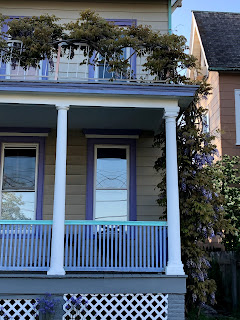Some people simply cannot abide any toe-clip overlap. Me, I can stand a little, depending on the bike and how I'm riding it. But this is, shall we say, a bit out of my range.
What's worse is the way it was achieved, if you will:
I'm thinking now of Rigi bikes from about 40 years ago. Its creators made the wheelbase shorter by splitting the seat tube in two--rather like the top tube on a mixte frame--and running the wheel between the smaller tubes:

I've heard of a bike that does the same thing with the down tube: The front wheel runs through it. I don't know how one steer such a machine. The only possible use I can see for it is a motor-paced time trial.
Now I'll dispense with the levity: As you probably have surmised, I didn't try to alter Arielle's geometry. Rather, it happened--in front of a nondescript tenement on Bonnefoy Avenue in New Rochelle.
I was pedaling, at a pretty good pace, home from Connecticut. Well, I thought I was going home: I hit something and, the next thing I knew, I was getting stitched up. Then someone in the New Rochelle hospital decided I should be observed in a trauma unit, to which I was sent.
Poor Arielle. As for me, I still feel pain on the sides of my neck down to my shoulders. Oh, and I have a headache and have been tired. A trip to the drugstore felt like a century or a marathon.
When I got home, my face looked as if someone had superimposed a railroad map over a satellite image of the Martian surface. It's a little better now, but I don't think I'll be modeling for Raphia any time soon.
I hate asking for money, but I think the real pain will begin when I see what my insurance doesn't cover. So, I've set up a GoFundMe page.
I hope, more than anything, to be back in the saddle soon. Until then, I'm going to catch up on some reading, writing and a project. And Marlee is going to catch up with, well, the cuddles she misses when I'm out of the house!
Thank you!
What's worse is the way it was achieved, if you will:
I'm thinking now of Rigi bikes from about 40 years ago. Its creators made the wheelbase shorter by splitting the seat tube in two--rather like the top tube on a mixte frame--and running the wheel between the smaller tubes:

I've heard of a bike that does the same thing with the down tube: The front wheel runs through it. I don't know how one steer such a machine. The only possible use I can see for it is a motor-paced time trial.
Now I'll dispense with the levity: As you probably have surmised, I didn't try to alter Arielle's geometry. Rather, it happened--in front of a nondescript tenement on Bonnefoy Avenue in New Rochelle.
I was pedaling, at a pretty good pace, home from Connecticut. Well, I thought I was going home: I hit something and, the next thing I knew, I was getting stitched up. Then someone in the New Rochelle hospital decided I should be observed in a trauma unit, to which I was sent.
Poor Arielle. As for me, I still feel pain on the sides of my neck down to my shoulders. Oh, and I have a headache and have been tired. A trip to the drugstore felt like a century or a marathon.
When I got home, my face looked as if someone had superimposed a railroad map over a satellite image of the Martian surface. It's a little better now, but I don't think I'll be modeling for Raphia any time soon.
I hate asking for money, but I think the real pain will begin when I see what my insurance doesn't cover. So, I've set up a GoFundMe page.
I hope, more than anything, to be back in the saddle soon. Until then, I'm going to catch up on some reading, writing and a project. And Marlee is going to catch up with, well, the cuddles she misses when I'm out of the house!
Thank you!






























